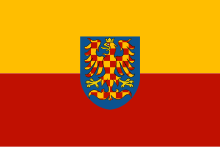
Moravia is a historical region in the east of the Czech Republic and one of three historical Czech lands, with Bohemia and Czech Silesia.
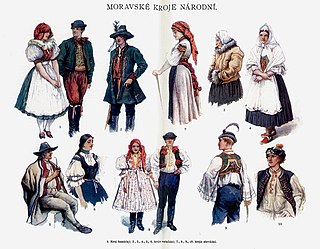
Moravians are a West Slavic ethnographic group from the Moravia region of the Czech Republic, who speak the Moravian dialects of Czech or Common Czech or a mixed form of both. Along with the Silesians of the Czech Republic, a part of the population to identify ethnically as Moravian has registered in Czech censuses since 1991. The figure has fluctuated and in the 2011 census, 6.01% of the Czech population declared Moravian as their ethnicity. Smaller pockets of people declaring Moravian ethnicity are also native to neighboring Slovakia.

The flag of the Czech Republic is the same as the flag of the former Czechoslovakia. Upon the dissolution of Czechoslovakia in December 1992, the Czech Republic kept the Czechoslovak flag while Slovakia adopted its own flag. The first flag of Czechoslovakia was based on the flag of Bohemia and was white over red. This was almost identical to the flag of Poland, so a blue triangle was added at the hoist in 1920. The flag was banned by the Nazis in 1939 as they established a government nominally in control of Bohemia and Moravia, and a horizontal tricolour of white, red, and blue was used for the duration of the war. The 1920–1939 flag was restored in 1945.
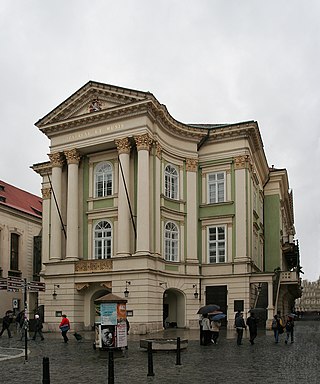
There are ten opera houses in the Czech Republic. The most important are the two opera houses in Prague - National Theatre (Prague) and Prague State Opera.

The flag of Bohemia is a historic flag, which now forms part of the design in the modern flag of the Czech Republic. The flag, a horizontal bicolour, was based on the colours of the former monarchs of Bohemia.

Hustopeče is a town in Břeclav District in the South Moravian Region of the Czech Republic. It has about 6,400 inhabitants. It is known for fruit and wine growing.

The coat of arms of the Czech Republic is divided into two principal variants. Greater coat of arms displays the three historical regions—the Czech lands—which make up the nation. Lesser coat of arms displays lone silver double-tailed lion in red shield. The current coats of arms, which was adopted in 1992, was designed by Czech heraldist Jiří Louda.
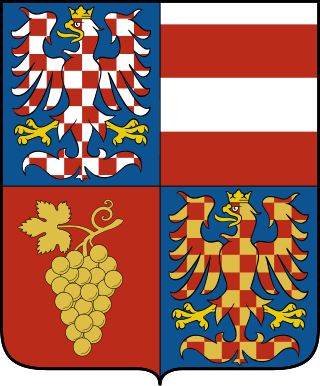
Wine in the Czech Republic is produced mainly in southern Moravia, although a few vineyards are located in Bohemia. However, Moravia accounts for around 96% of the country's vineyards, which is why Czech wine is more often referred to as Moravian wine. Production centers on local grape varieties, but there has been an increase in the production of established international strains such as Cabernet Sauvignon.

Moravané is a small non-parliamentary political party in Moravia in the Czech Republic.

Moravian traditional music or Moravian folk music represents a part of the European musical culture connected with the Moravian region of the Czech Republic. Styles of Moravian traditional music vary by location and subject, but much of it is characterized by a specific melodic and harmonic texture related to the Eastern European musical world. According to Czech musicologist Jiří Plocek, Moravia is the area where the European East musically meets the West.
Intimate Sketches is a collection of piano miniatures by Czech composer Leoš Janáček (1854–1928) published in 1994, sixty-six years after his death.

The Margraviate of Moravia was one of the Lands of the Bohemian Crown within the Holy Roman Empire and then Austria-Hungary, existing from 1182 to 1918. It was officially administered by a margrave in cooperation with a provincial diet. It was variously a de facto independent state, and also subject to the Duchy, later the Kingdom of Bohemia. It comprised the historical region called Moravia, which lies within the present-day Czech Republic.

Moravian Library is the second largest library in the Czech Republic. Located in Brno, Czech Republic, it is a universal research library and the regional library of the South Moravian Region.

The national symbols of the Czech Republic are flags, heraldry, cultural expressions and other symbols that represent the Czech Republic, Czech people and their history, culture and nationhood. There are six official symbols which are declared in the Constitution of the Czech Republic. However many other historical, cultural and geographical symbols of the Czech republic and Czech people do exist.

The coat of arms of Moravia has been used for centuries to represent Moravia, a traditional province in the present-day Czech Republic. The coat of arms is also present in a field of the coat of arms of the Czech Republic.

The national colours of the Czech Republic are one of the national symbols of the Czech Republic, which officially represent the Czech Republic. The colours forming tricolour are in the following order: white, red and blue. The national colours come from the coat of arms of the Czech Republic.

Moravian cuisine encompasses the cooking styles, traditions and recipes associated with Moravia, a region of the Czech Republic and historically belongs to the Moravia, former historical country in Central Europe. Today, it is often perceived as an integral part of Czech cuisine, to which it has over the last century been artificially accommodated and mixed. Nevertheless, there is a large list of dishes, drinks and customs that are original only for Moravia.

The Moravian Land Movement is a political party in the Czech Republic that campaigns for the establishment of an autonomous region in Moravia and Czech Silesia. It was founded in 2018 as a breakaway from Moravané and claims to be the successor to the Movement for Autonomous Democracy–Party for Moravia and Silesia.

Dědice is an administrative part of the town of Vyškov in the South Moravian Region of the Czech Republic. According to archeological findings, Dědice is one of the oldest settlements in Moravia. In the town there is a parish church of the Holy Trinity, in the tower of which there is a protected area, in which Greater mouse-eared bat stays during the summer. There have been military barracks in Dědice since 1935.
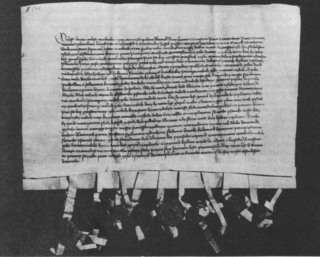
The Moravian Margrave Wars were a turbulent period of fighting, skirmishes, robbery and lawlessness that took place especially in Moravia at the turn of the 14th and 15th centuries.

